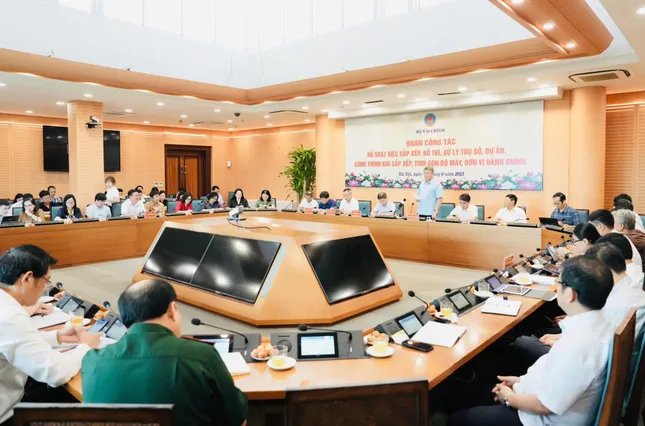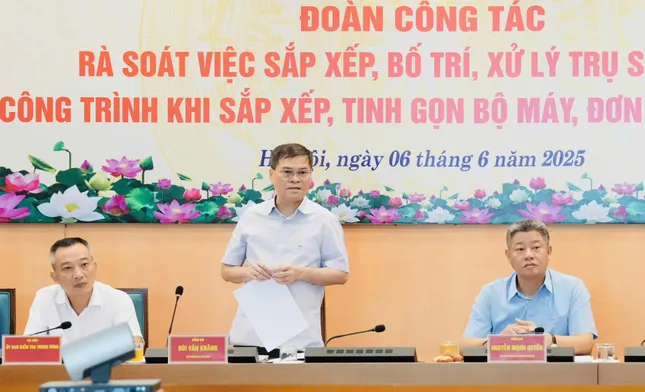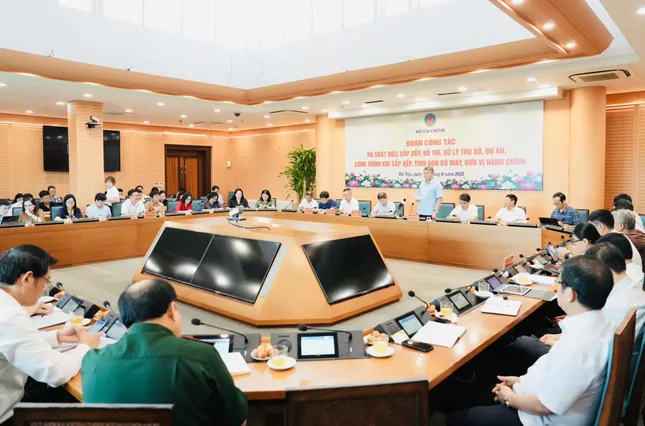On June 6, a task force from the Ministry of Finance, led by Deputy Minister Bui Van Khanh, worked with the Hanoi People’s Committee to review the arrangement, allocation, and handling of offices, projects, and constructions in the process of streamlining administrative units and organizations.
According to a report by the Hanoi Department of Finance, before the reorganization, Hanoi had 526 communes, wards, and towns, along with 30 district-level units. After the reorganization, it is expected to reduce to 126 wards. This reorganization leads to several issues related to the handling of offices, public land, and construction projects.
The review identified that Hanoi is managing over 5,200 offices and operational establishments with a total land area of approximately 27 million square meters and a building area of 17 million square meters. Out of these, 291 redundant facilities require handling post-reorganization.

Work meeting panorama. Photo: Hong Thai
A total of 1,206 projects were impacted by the administrative unit reorganization (including 1,194 city projects and 12 projects of the city’s People’s Procuracy). So far, the city has temporarily halted 561 projects and decided to continue with 645 projects. Simultaneously, the city directs the classification and handling of these projects into four groups: continuing with the initial investment scale, adjusting the scale, halting the project, or handling it through other methods.
However, there are still some challenges and obstacles in the implementation process, especially regarding specific regulations on standards and norms for the use of offices, equipment, and machinery (the basis for arranging and handling redundant assets after administrative unit reorganization), which are currently being finalized and promulgated…
Prevent public asset waste after reorganization
Speaking at the meeting, Vice Chairman of the Hanoi People’s Committee, Nguyen Manh Quyen, proposed that central ministries and sectors promptly issue norms and standards (including salary, income, and physical infrastructure) to effectively implement the streamlining of administrative units and organizations, along with the Law on the Capital City.
Regarding decentralization and authorization, Mr. Nguyen Manh Quyen suggested decisive and thorough implementation with the two-level administration from July 1st. With the context of assigning officials and civil servants from the district level to work in 126 wards, decentralization and authorization to the ward level are necessary to promote the capacity of the official team.

Deputy Minister of Finance Bui Van Khanh concludes the meeting
Deputy Minister of Finance Bui Van Khanh stated that after the reorganization, units and localities must efficiently utilize the offices to serve the essential needs of the people in those areas. Therefore, proper arrangement, handling, and proposals before the reorganization are crucial to avoid post-reorganization repairs and replacements due to incompatibility.
Regarding redundant land and buildings, Mr. Bui Van Khanh requested the city to develop a handling plan based on the “6 Clear” principle as directed by the Prime Minister: Clear person, clear task, clear time, clear responsibility, clear product, and clear authority. Simultaneously, regularly update the list of newly arising redundant land and buildings to ensure that public asset handling is implemented synchronously, effectively, economically, and in accordance with legal regulations…
















